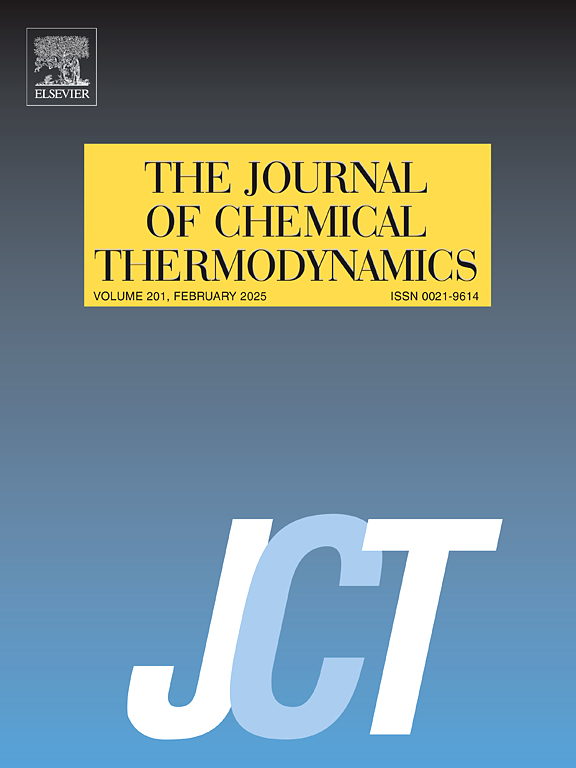Measurement, correlation, and modeling of volumetric, viscosimetric, acoustic, and optical properties in ternary mixtures of alcohols, ethers, and hydrocarbons between 298.15 and 313.15 K
IF 2.2
3区 工程技术
Q3 CHEMISTRY, PHYSICAL
引用次数: 0
Abstract
New experimental data on density (), dynamic and kinematic viscosities, for the following ternary mixtures: 2-butanol (Belale and F.E. M'hamdi Alaoui, M. Lifi, Y.Chhiti, M. Elkhouakhi, L., 2020 (1)) + isopropyl ether (Alaoui et al., 2015 (2)) + 1-hexene (Abala and Lifi, 2021 (3)) and 2-propanol (Belale and F.E. M'hamdi Alaoui, M. Lifi, Y.Chhiti, M. Elkhouakhi, L., 2020 (1)) + isopropyl ether (Alaoui et al., 2015 (2)) + 1-hexene (Abala and Lifi, 2021 (3)) are presented in this work at four temperatures between 298.15 and 313.15 K and = 0.1 MPa. Additionally, the speed of sound () and refractive index () for the same ternary mixtures were measured at 298.15 K and 313.15 K. Various derived properties were calculated from the experimental results of these thermophysical properties, including excess volume, deviation in refractive index, , deviation in dynamic viscosity, deviations in speed of sound, isentropic compressibility, and deviation in isentropic compressibility, The Redlich-Kister equation and the typical semi-empirical Cibulka equations were used to correlate all of these derived properties. Moreover, the Perturbed-Chain Statistical Associating Fluid Theory (PC-SAFT) equation of state was employed to fit the experimental density data, and good agreement between the experimental and modeled density results for the binary mixtures studied.
298.15和313.15 K之间的醇、醚和碳氢化合物的三元混合物的体积、粘度、声学和光学性质的测量、关联和建模
下列三元混合物的密度(ρ),动态和运动粘度,ημ的新实验数据:2-丁醇(Belale和F.E. M'hamdi Alaoui, M. Lifi, Y.Chhiti, M. Elkhouakhi, L., 2020(1)) +异丙基醚(Alaoui等,2015(2))+ 1-己烯(Abala和Lifi, 2021(3))和2-丙醇(Belale和F.E. M'hamdi Alaoui, M. Lifi, Y.Chhiti, M. Elkhouakhi, L., 2020(1)) +异丙基醚(Alaoui等,2015(2))+ 1-己烯(Abala和Lifi, 2021(3))在298.15至313.15 K和p = 0.1 MPa之间的四种温度下进行了研究。此外,在298.15 K和313.15 K下测量了相同三元混合物的声速(u)和折射率(nD)。根据这些热物理性质的实验结果计算了各种衍生性质,包括多余体积,VE,折射率偏差,∆nD,动态粘度偏差,∆η,声速偏差,∆u,等熵可压缩性,ks和等熵可压缩性偏差,∆ks。Redlich-Kister方程和典型的半经验Cibulka方程被用来关联所有这些导出的性质。采用微扰链统计关联流体理论(PC-SAFT)状态方程对实验密度数据进行拟合,实验结果与模型结果吻合较好。
本文章由计算机程序翻译,如有差异,请以英文原文为准。
求助全文
约1分钟内获得全文
求助全文
来源期刊

Journal of Chemical Thermodynamics
工程技术-热力学
CiteScore
5.60
自引率
15.40%
发文量
199
审稿时长
79 days
期刊介绍:
The Journal of Chemical Thermodynamics exists primarily for dissemination of significant new knowledge in experimental equilibrium thermodynamics and transport properties of chemical systems. The defining attributes of The Journal are the quality and relevance of the papers published.
The Journal publishes work relating to gases, liquids, solids, polymers, mixtures, solutions and interfaces. Studies on systems with variability, such as biological or bio-based materials, gas hydrates, among others, will also be considered provided these are well characterized and reproducible where possible. Experimental methods should be described in sufficient detail to allow critical assessment of the accuracy claimed.
Authors are encouraged to provide physical or chemical interpretations of the results. Articles can contain modelling sections providing representations of data or molecular insights into the properties or transformations studied. Theoretical papers on chemical thermodynamics using molecular theory or modelling are also considered.
The Journal welcomes review articles in the field of chemical thermodynamics but prospective authors should first consult one of the Editors concerning the suitability of the proposed review.
Contributions of a routine nature or reporting on uncharacterised materials are not accepted.
 求助内容:
求助内容: 应助结果提醒方式:
应助结果提醒方式:


